 Gilman Studio On-Line Lessons
Gilman Studio On-Line Lessons
Yang Style Long Form
Tai Chi Chuan
This Lesson Contains:
Movement # 30 – Needle At Sea Bottom
This is a beautiful movement, yet there are many places where the student can go wrong. Pay close attention and you’ll end up with something that is useful and healthy.
Partner grabs my right hand with her right hand. I apply a Chin Na (joint locking) technique, and then I pull her down (Tsai Jing). Chin Na is very effective at controlling an opponent with out hurting them, unless they resist.
When bending the waist to pull partner downward, keep the back straight. Do not bend it. You want the pull down energy (Tsai Jing) to come from the center, not the upper back. If trying this with a practice partner, please be especially careful. I little bit too much can really hurt.

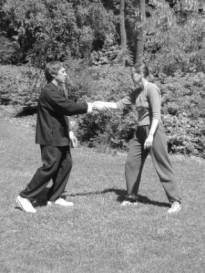 Anna grabs my right hand with her right hand. I relax my arm and send my energy into my center to see what will happen next.
Anna grabs my right hand with her right hand. I relax my arm and send my energy into my center to see what will happen next.
Sink the weight into the left foot and Kua. Roll up the right foot onto the toe. I am ready to go with a pull forward by Anna or move back quickly in case of an attack.
The two arms relax and stay in the same relative positions.
Be careful not to lean forward at the waist as you roll up the back foot.
Focus on moving most of the energy to the Dan Tien, keeping some awareness in the right hand for listening to partner’s energy.
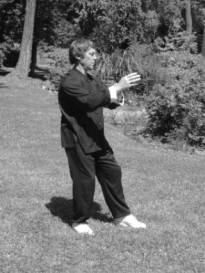
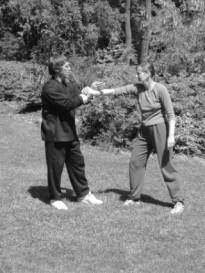 Since Anna is well rooted, I decide to take control with a Chin Na technique.
Since Anna is well rooted, I decide to take control with a Chin Na technique.
Replace the right foot in the same place or step up slightly. Pull the left foot back into Ding Bow Toe. Here I am closing the distance a bit to get better leverage for what is to follow. Keep the weight down.
The right hand makes a small clockwise circle. This movement is mostly a wrist circle that actually comes from the center, as do all movements. The left hand moves up and touches the right wrist, almost like taking your pulse.
This technique works well if partner holds on tightly. As you circle, partner’s forearm gets twisted. Your left hand comes up to hold her fingers in place so she can’t just let go. Notice the detail in the next picture.
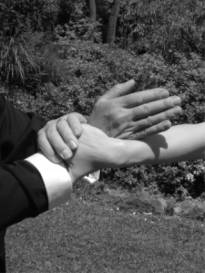 I think this is a beautiful picture, and not just because it is I who is applying the lock.
I think this is a beautiful picture, and not just because it is I who is applying the lock.
What is important here is to get your right fingers up and over partner’s wrist and have your fingers pointing to your partner. The higher up on the side of your hand, the easier this technique will be to apply. Be sure to firmly hold her fingers in place.
This action does not look like it could do very much. Try it with a partner and be careful. It can really be painful when applied correctly.
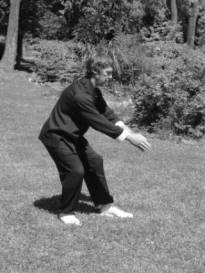
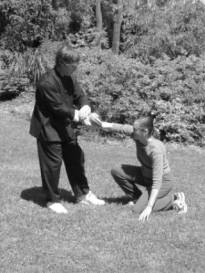 I now apply the downward, and inward to her, pressure to Anna’s wrist and forearm. She has to move down in order to try and relieve the pain. If I do the movement slowly and steadily, I can control her. If I apply a sharp, snapping energy, I could break her wrist.
I now apply the downward, and inward to her, pressure to Anna’s wrist and forearm. She has to move down in order to try and relieve the pain. If I do the movement slowly and steadily, I can control her. If I apply a sharp, snapping energy, I could break her wrist.
The body bends at the waist until the back is at a 45-degree angle. The legs do not move. This is a waist bend. Be careful not to put weight on the left toe. You could be pulled forward, and you would lose the ability to kick with the left toe.
The hands stay in the same position but expand out (Peng Jing) as the body pulls down (Tsai Jing). Make sure that the right fingers face the opponent.
Focus on the pulling down and expanding out of the two arms.
